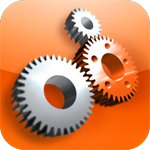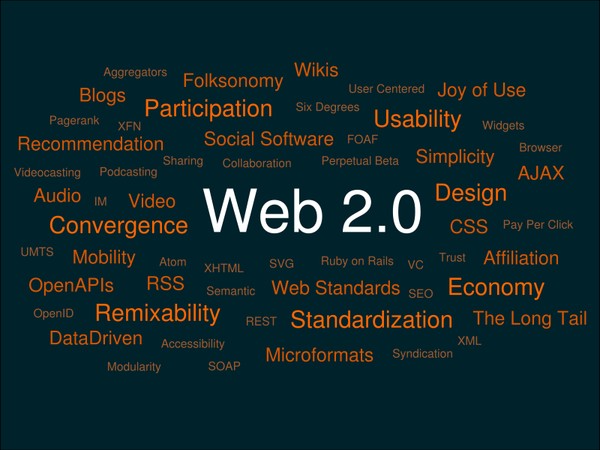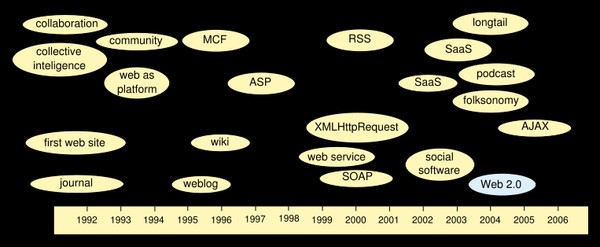Web 2.0? or is it more like Web 16.0?
With people generating many new phrases and terms in modern technology, it has become hard to keep up with what they all mean. One of the most commonly used terms on the world wide web (www) today is the phrase "Web2.0".
It seems like every web solutions company trying to make a living is selling their stuff off the phrase. So to the average Joe who is not a geek, what is "Web2.0"?
Well according to Wikipedia, the free online encyclopedia...
"The phrase Web2.0 refers to a perceived second generation of web-based communities and hosted services — such as social-networking sites, wikis andfolksonomies - which aim to facilitate collaboration and sharing between users. The term became popular following the first O'Reilly Media Web 2.0 conference in 2004, and has since become widely adopted as shorthand for user generated content shared with other users.
Although the term suggests a new version of the World Wide Web (www), it does not refer to an update to Web technical specifications, but to changes in the wayssoftware developers and end-users use and interact with the web as a platform. According to Tim O'Reilly, "Web2.0 is the business revolution in the computer industry caused by the move to the internet as platform, and an attempt to understand the rules for success on that new platform."
Some technology experts, notably Tim Berners-Lee, have questioned whether one can use the term in a meaningful way, since many of the Technology components of "Web2.0" have existed since the early days of the Web."
There is no doubt the www has advanced significantly since inception and it seems every year the advancements outstrip the sum total of all the previous years put together.
The point to note is there really is no new version of the www. It is simply that it is now much more useful and usable to the everyday person. As offerings are developed, various players try, buy and dump what works less well, a Darwinian of what works, works. You will often read and hear about an "amazing wave of technology and innovation on the web" which is usually more marketing than meaningful changes.
In reality more and more people are finding the www to be an increasingly reliable and useful tool in their work and everyday life needs.
There has been a large volume of banter and amazement at this new flood of 'amazing' innovation, especially so since almost all of the technology supposedly "driving the Web2.0 revolution" has been around for a while. Maybe the most significant change is increasing bandwidth and anywhere access.
So why do people think all of this technology is brand new? And why are we calling it Web2.0 when realistically if we counted each major innovation as a number and each minor revision as a sub-number we are already into double digits.
If you have seen the latest Die Hard movie, or even bought software for your computer, you will understand why we are not in the Web2.0 revolution, Like Die Hard 4.0 and MS Office 2007 they are all still the same movie or tool you used before only they are the latest version. What we are really experiencing now on the www is something more like Web16.0.
And if you manage to get into an in-depth, honest conversation with your web designer then they will tell you that Web2.0 is a myth. So to explain how we get to Web16.0 we have compiled a history of the most significant events in the history of the www.
WEB 0.1 ----- 1958 – SAGE – Radar systems are first networked
WEB 0.2 ----- 1960 – Packet Switching is first created
WEB 1.0 – EMAIL – “A New Way to Send Unsolicited Mail Is Born”
Although the exact history of E-Mail is a tad murky, it is generally accepted that it appeared in 1965, and was created so that people accessing a mainframe could communicate with each other. This was the first step in the interconnection of people, and also facilitated almost instant communication at no cost to the user.
WEB 1.1 ----- 1967 – Markup – Markup language is created
WEB 1.2 ----- 1969 – ARPA – A link is established between computers
WEB 1.3 ----- 1696 – ARPA Net – First packet switched network created
WEB 2.0 – WYSIWYG – “What You See Is What You Get (sometimes)”
With the invention of WYSIWYG in 1970, users could now be presented with a basic display of what their finished product would look like, as they were working on it. This removed the need to memorize complex code, much in the same way you need to know code to create a web-page.
WEB 2.1 ----- 1970 – ASP – First Application Service Provider (SAAS)
WEB 2.2 ----- 1970 – Style sheets are created
WEB 2.3 ----- 1971 – @ is created to separate hosts and users
WEB 2.4 ----- 1973 – TCP/IP is created to simplify networking. This is probably the real starting point.
WEB 2.5 ----- 1973 – First connection to another country established
WEB 2.6 ----- 1974 – The term "Internet" is adopted
WEB 2.7 ----- 1976 – X.25 – The first network standard is approved
WEB 2.8 ----- 1978 – International packet switching service created
WEB 3.0 – USENET– “The Black Market of the Internet”
Usenet was established in 1980 to offer mail and file transfers as well as give personal users access to news. Usenet is in fact a large network of servers all in communication with each other, a user posts something to the local server and that item is sent to the other servers and passed along in a giant network. Usenet was a major turning point because now users can have an open conversation with anyone on the net, as opposed to having to specifically know the user (unlike E-Mail). The downside is that with a sometimes un-policed net capable of file transfers, the Usenet of today is a haven for piracy of all types, where anything you can imagine is accessible.
WEB 3.1 ----- 1979 – Email is made available to personal computer users, millions of Nigerian Princes suddenly need public help
WEB 4.0 – REAL TIME CHAT – Going Outside Deemed "Obsolete"
Real-Time Chat was created in 1980 following users' frustrations with Usenet articles taking sometimes 24 hours to be updated. This signalled a turning point whereby online conversations became instant, albeit isolated into segregated groups.
WEB 4.1 ----- 1980 – First ISP's created providing dialup internet
WEB 4.2 ----- 1981 – TCP/IP becomes a standard
WEB 4.3 ----- 1981 – US/Europe/Canada/Hong-Kong/Australia Connect
WEB 4.4 ----- 1983 – TCP/IP becomes the only standard
WEB 4.5 ----- 1983 – First wide area network using TCP/IP operational
WEB 4.6 ----- 1985 – FTP – The File Transfer Protocol is created
WEB 4.7 ----- 1988 – IRC – Internet Relay Chat is created
WEB 4.8 ----- 1988 – Bulletin Board Systems and Forums created
WEB 5.0 – HTML/HTTP/Web-Pages – "It Has Begun…"
Around 1980 there were many researchers using the internet, but no single way to create/display "documents" (web-pages). A physicist Tim burners-Lee and his colleagues needed a simple system for creating/displaying "documents" (web-pages) but found that they were too commercial, platform-specific or complicated for the average user.
So they created their own relatively simple system consisting of browsing software called "WorldWideWeb", a protocol for transmitting the information (HTTP) and a document annotation convention "HyperText Markup Language" (HTML). This meant anyone could now create web-pages using a simple language for page creation.
WEB 5.1 ----- 1989 – Images can now be animated, Oh the horror!
WEB 5.2 ----- 1990 – The network now covers the entire world (publicly)
WEB 6.0 – Search – “Did You Mean: Google”
Before search engines were created there was no way to find a page, you had to specifically know the location. With the advent of search engines in 1990 you could now search within a directory if you could provide the directory location. Around 1991 search engines begun indexing (storing) the content they found, giving users the ability to search for pages even if they didn't know the page's location.
WEB 6.1 ----- 1991 – DNS – A Dynamic Naming System is created
WEB 6.2 ----- 1991 – The first text-based browser is created
WEB 7.0 – DHTML – “Because Non-Scrolling Text Is Boring”
The web was static until Dynamic HTML (DHTML) was created. DHTML introduced client-side scripting, allowing authors to include code in their web-pages that performed an action upon being downloaded onto a user's computer, introducing rollover buttons and drop-down menus on web-pages. DHTML is an extremely broad concept, and encompasses any web-page that is generated differently for each user, it goes a long way to making the web more personalized.
WEB 7.1 ----- 1993 – The first graphics based browsers are created
WEB 7.2 ----- 1993 – Screen casts are first created
WEB 7.3 ----- 1994 – Wiki's are created, Britannica begins holding breath
WEB 7.4 ----- 1994 – The world-wide web consortium is formed
WEB 7.5 ----- 1994 – CSS – Cascading Style Sheets created
WEB 8.0 – ONLINE DIARIES – “Teens Reportedly Misunderstood"
Online diaries were first created in 1994 as a means for people to store their diaries online for personal or public reading. As other diarists discovered each other, a web-ring was set up to link them together and eventually a community web-site was setup and began giving "Diarist Awards" quarterly. Writers could now reach almost anyone worldwide at practically no cost, and everyone can create an editorial on whatever subject they like, without fear of censorship.
WEB 8.1 ----- 1996 – The first social bookmarking site created
WEB 9.0 – RANKED RESULTS – “The Online Popularity Contest”
Search engine results helped find things, but many of the results were useless or had nothing to do with the keywords you had used. As of 1996 search results started to be ranked based on a multitude of things, like how popular a page is. This made searching faster and easier, and significantly less painful.
WEB 9.1 ----- 1996 – Flash is created, whole websites can now be animated
WEB 9.2 ----- 1997 – The term "Blog" is adopted
WEB 10.0 – HIRED BLOGGERS – "Wow Isn't Product X Great!"
As of 1997 personal diaries began to evolve to what became known as "blogs." Many corporate websites and personal homepages had (and still do have) news sections, these were traditionally manually updated in a back-end system. With the advent of blogs, tools had evolved to facilitate the production and maintenance of web articles, and the commercial sector jumped on, seeing blogs as a new marketing medium.
WEB 10.1 ----- 1998 – The first Audio news site is created
WEB 10.2 ----- 1999 – The first web-based operating system is created
WEB 11.0 – RSS – “Newspapers Deemed Obsolete"
Really Simple Syndication (RSS) was created due to the lack of a feed format that was universal. The creation of RSS means that users can now "subscribe" to feeds containing video, audio, text, or graphics. Users no longer have to trawl the web for new information, they can "subscribe" to a feed and have it sent to them directly, tailoring the news they read to the content they enjoy.
WEB 12.0 – REMOTE SCRIPTING – “Waiting For 4 Seconds Now History!”
Remote scripting allows scripts running inside a browser to exchange information with a server, so that scripts can be triggered locally, processed remotely and have information returned directly to the browser, requiring no refresh. This makes the web faster and easier to use, and removes the need to refresh the page to do simple things like sorting.
WEB 12.1 ----- 2001 – Blogs evolve from online diaries
WEB 13.0 – PODCASTING – "Now Everyone Can Not Listen To You by Choice not Circumstance!"
Podcasting originated as a portmanteau of the iPod© and broadcast, though it has become widely accepted that the term means "portable on demand broadcast." Originally podcasting was created to allow individuals to distribute their own radio shows. But it has become popular for a wide variety of things, from distribution of educational materials, to the latest gaming news. Podcasting opens up distribution of audio content to anyone with a server, with users "subscribing" the RSS feed's that appeal to them.
WEB 13.1 ----- 2002 – Folksonomy is created, giving rise to "Tags"
WEB 14.0 – VIDEO PODCASTING – “Web-Based One-Sided Conversations”
Shortly after Podcasting became popular, video Podcasting was created as a means to send the equivalent of TV episodes to users, though similarly to podcasting, the content was not limited to just "TV episodes". Video Podcasting opens up the video medium so that making a TV show is not possible for anyone.
WEB 15.0 – VOIP – “High Tech, Dodgy Sounding Free Calls”
With the Voice over Internet Protocol (IP) instead of using a traditional phone line to send audio, the audio is sent over the internet. This removes almost all cost involved, and also removes the need to have a physical phone line to plug into. What this means for consumers is calling becomes much simpler, easier and significantly cheaper.
WEB 16.0 – SAAS – “The Industry Makes a SaaS of Itself.”
Software as a Service (SaaS) is in-fact just a new term for a concept that has been around since the dawn of the internet (ASP from 1970). ‘Software as a Service’ is the concept of using a piece of software run/provided through the internet, and instead of paying a large one-off purchase price, you "rent" the software for as long as needed. So whilst ‘SaaS’ is the buzzword of the day, the concept is decades old.
...The CONCLUSION?
So if you follow the basic rule that each total upgrade is a new ".0" then we are nowhere near Web2.0. The story is really one of falling price, increasing reliability and bandwidth coupled with ubiquitous access.
We have made significant strides in technology, and chalking these up as a recent affair is both factually incorrect as well as just plain rude to the original inventors. But then why is "Web2.0" used on an almost daily basis when describing the latest venture Google has gotten into, or a new ‘simple looking’ piece of software released by an unknown Swedish developer?
Simply put, "Web2.0" is just shorthand for the development process outlined above. Bottom line, the web really becoming what the web really always should have been.
The web, once seen as a commercial gains-platform, is now seen as more user driven. The rules are different, there is a need to figure out new web ways. Consumers have jumped on and realized that the playing field has levelled, a 15 year old blogger can reach as many people in the world as a famous BBC journalist.
Users are customers, the guiding principles "look after the users" and "make it appealing to the eye". We don't need newspaper editors to tell us what the news is, we read our news with all the content tailored to our tastes, we listen to music not by artist, but instead based on the "tags" that we have come to know and love.
Call it what you will, the web is the power of difference, everyone can have a say but nobody need listen – it’s scary, irreverent, anarchistic and fun!
———
Article researched and written by:
Julian Stone, Sam Law – Project and Time Management Specialists from ProActive Software - http://www.proworkflow.com
Peter Hodge – Editor and Contributor from InfoNews – http://www.infonews.co.nz
Disclaimer: Facts are as accurate as could be researched at the time.
———
Note: If reproducing this article, the links and paragraph above must be included.


